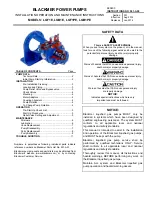
9
English
(US)
6. Operation
5.1 Priming
• The PACO Type L pump is not self-priming, and must be
completely primed (filled with liquid) before starting.
• If the pump will operate with a positive suction head, prime by
opening the suction valve and allowing liquid to enter pump
casing. Open air vents at this time, and make sure all air is
forced from pump by liquid before closing.
• Rotate the shaft by hand to free entrapped air from impeller
passageways.
• If pump has a suction lift, priming must be accomplished by
other methods. The use of foot valves or ejectors, or manual
filling of the pump casing and suction line with liquid are
possible methods suggested for this purpose.
• CAUTION: Never run the pump dry in the hope that it will
prime itself! Serious damage to the mechanical seal will result.
6.2 Pre-start checklist
Make the following inspections before starting your PACO Type L
pump:
1. Make sure the suction and discharge piping has been cleaned
and flushed to remove dirt and debris before operating pump.
2. Double check rotation must be clockwise operating in reverse
will destroy the impeller and shaft.
3. Make sure all wiring connections to the motor (and starting
device) match the wiring diagram and produce clockwise
rotation as viewed from the back of the motor.
4. If the motor has been in storage for an extended length of
time, either before or after installation, refer to motor
instructions before starting.
5. Check the voltage, phase, and line circuit frequency with the
motor nameplate. Turn rotating element by hand to make sure
it rotates freely.
6. Tighten plugs in gauge and drain taps. If the pump is fitted
with pressure gauges, keep gauge clocks closed when not in
use.
7. Check suction and discharge piping for leaks, and make sure
all flange bolts are securely tightened.
6.3 Motor rotation
After the unit has been wired and checked to insure that all
components in the system (disconnect device, magnetic starters,
pilot devices and motors) are properly connected, check motor
rotation as follows:
• For 3 phase units only—momentarily energize the motors to
ensure that the rotation is correct as indicated by the arrow
cast into the pump volute. If rotation is incorrect, interchange
two wires at the motor starter terminals T1 and T2.
• IMPORTANT: The pumps must not be operated while dry. Use
extreme caution that motors are energized only momentarily to
determine proper rotation.
6.4 Starting the pump
1. Install coupling guard on coupled units.
2. Fully open gate valve (if any) in suction line, and close gate
valve in discharge line.
3. Fill suction line with liquid and completely prime pump.
4. Start the motor (pump).
5. Immediately make a visual check of pump and suction piping
for pressure leaks.
6. Immediately after pump reaches full operating speed, slowly
open the discharge gate valve until complete system flow is
achieved.
7. Check discharge piping for pressure leaks.
8. If pump is fitted with pressure gauges, open gauge cocks and
record pressure reading for future reference. Verify that the
pump is performing in accordance with parameters specified
on performance curve.
9. Check and record voltage, amperage per phase, and
kilowatts, if a wattmeter is available.
Caution
Never run the pump dry in the hope that it will
prime itself! Serious damage to the shaft seals,
pump wear rings and shaft sleeves will result.
Warning
In the interest of operator safety, the unit must
not be operated above the nameplate conditions.
Such operation could result in unit failure
causing injury to operating personnel. Consult
instruction book for proper operation and
maintenance of the pump and its supporting
components.
Caution
Never check driver rotation unless pump and
driver couplings are disconnected and physically
separated. Failure to follow this instruction can
result in serious damage to pump and driver if
rotation is wrong.
Warning
The pump must not be operated without an
approved coupling guard in place. Failure to
observe this warning could result in injury to
operating personnel.
PA
CO Pumps
12













































